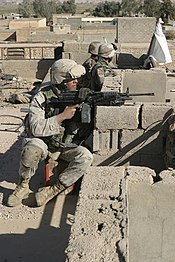| Operation Sayeed | |||||||
|---|---|---|---|---|---|---|---|
| Part of Al Anbar campaign and Iraq War | |||||||
 U.S. Marine Lcpl. Raphael Hernandez, and Iraqi Army soldiers watch over the surrounding streets from a rooftop in Karabilah, Iraq, during Operation Steel Curtain on 11 November 2005. | |||||||
| |||||||
| Belligerents | |||||||
|
Ansar al-Sunna Other Insurgents | |||||||
| Commanders and leaders | |||||||
|
(ISOF commander) |
Sulaiman Darwaish † (AQI leader in Qaim); Saeed Huwair (former army officer); Abdul-Samad Ghurairi (Baath leader); Muhannad Ulayyan (Islamic Army in Iraq commander); Farhan Khalifawi (Islamic Army in Iraq commander); Hatim Muslim (Ansar al-Sunnah commander); Mulla Hamidi Jughaifi (AQI leader in Haditha); Fulaih Mazid (Ansar al-Sunnah commander) | ||||||
| Casualties and losses | |||||||
|
|
U.S claim: 757 killed 64 wounded 2,308 detained[1] | ||||||
Operation Sayeed (Arabic: عملية الصياد) also known as Operation Hunter in English, was a series of operations conducted in western Al Anbar Governorate by the United States Marine Corps in 2005. It was an umbrella operation, consisting of at least 11 named operations between July 2005 to December 2005. The purpose was to drive Al-Qaeda in Iraq forces from the Western Euphrates River Valley. Some parts of Operation Sayeed were Operation Steel Curtain and Operation Iron Fist.[2]
There were three goals of Operation Sayeed, in addition to removing AQI from the Western Euphrates River Valley; they were to ensure there was a secure "climate" and "environment" to conduct a referendum in October and national elections in December 2005; and the third was to secure the control of the Iraqi border to the Iraqi people.[3] Al-Anbar Governorate was divided into areas of operations: II Marine Expeditionary Force (codenamed Operation Atlanta) included Area of Operations Denver (western region), Area of Operations Topeka (Ramadi and surrounding area), Area of Operations Raleigh (Fallujah and surrounding area) and Area of Operations Oshkosh (al-Taqaddum).[4]
- ^ a b c U.S. Marine Corps Operations in Iraq, 2003–2006, p. 105
- ^ Al-Anbar Awakening: U.S. Marines and Counterinsurgency in Iraq, 2004–2009. Volume 1: American Perspectives, p. 105
- ^ McWilliams, Timothy S., and Wheeler, Kurtis P., Al-Anbar Awakening: Volume 1 (American Perspectives U.S. Marines and Counterinsurgency in Iraq, 2004-2009), 2015, CreateSpace Independent Publishing Platform, ISBN 1511645989 ISBN 978-1511645980
- ^ W Estes, Kenneth U.S. Marines in Iraq, 2004–2005: Into the Fray: U.S. Marines in the Global War on Terror, 2011, CreateSpace Independent Publishing Platform, ISBN 1470095076 ISBN 978-1470095079
© MMXXIII Rich X Search. We shall prevail. All rights reserved. Rich X Search
